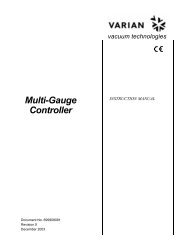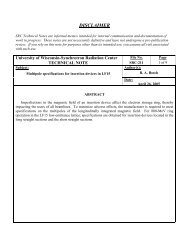SRC Users' Meeting - Synchrotron Radiation Center - University of ...
SRC Users' Meeting - Synchrotron Radiation Center - University of ...
SRC Users' Meeting - Synchrotron Radiation Center - University of ...
Create successful ePaper yourself
Turn your PDF publications into a flip-book with our unique Google optimized e-Paper software.
THE FERMI SURFACES OF THIN Sb(111) FILMS<br />
Hartmut Höchst and Christian R. Ast<br />
<strong>Synchrotron</strong> <strong>Radiation</strong> <strong>Center</strong>, <strong>University</strong> <strong>of</strong> Wisconsin-Madison<br />
3731 Schneider Drive, Stoughton, WI, 53589<br />
The unique electronic properties <strong>of</strong> the group-V elements Sb and Bi, their small<br />
Fermi energy combined with highly anisotropic electron and hole masses and carrier<br />
concentrations several orders <strong>of</strong> magnitude lower than in normal metals makes them<br />
prime candidates for potential thermoelectric converters. Devices based on nano-scale<br />
structures <strong>of</strong> Sb and Bi or alloys there<strong>of</strong> are among those with the highest conversion<br />
efficiency.[1,2]<br />
The rhombohedral (A7) crystal structure <strong>of</strong> the group V-elements causes a<br />
negative band gap. The conduction band minimum at the L-point is lower than the<br />
valence band maxima, which occur at the H-point for Sb and at the T-point for Bi. As a<br />
result, the Fermi surfaces (FS) consist <strong>of</strong> six pockets centered at the H-points or <strong>of</strong> two<br />
half-pockets centered at the T-points. Band structure calculations using different<br />
theoretical approaches agree in some basic overall Fermi surface features.[3-6].The<br />
calculated dimensions <strong>of</strong> the Fermi surface however have been far from experimental<br />
results based on magnetotransport and resonance measurements. These data were<br />
historically the most accurate even though indirect sources to judge the quality <strong>of</strong> the<br />
various theoretical approaches. More recently, photoemission spectroscopy (PES) was<br />
recognized to be a potentially useful additional tool to investigate the electronic<br />
properties near the FS. Compared to the classical FS measurements, PES has the<br />
advantage that information can be gathered from very small samples, at elevated<br />
temperatures and from materials, which exhibit strong impurity, compositional or<br />
structurally related scattering effects otherwise detrimental to most classical resonance<br />
based FS measurements.<br />
We report the first photoemission based FS data <strong>of</strong> Sb. Combining ARPES with<br />
the tuneability <strong>of</strong> synchrotron radiation allows determining the parallel components <strong>of</strong> the<br />
Fermi momentum k x and k y . Using a simple final state model provides also access to the<br />
perpendicular component k enables us to separate the three dimensional hole- pocket<br />
typical for bulk Sb from additional FS features which are <strong>of</strong> 2D-nature and most likely<br />
related to the presence <strong>of</strong> a Sb bilayer on the (111)-surface. Compared to Bi[7-9], which<br />
has extremely small bulk hole-pockets, preventing a detailed k-mapping due to<br />
experimental limitations in the momentum resolution, the carrier concentration in Sb is<br />
~200 times larger and thus opening up the possibility <strong>of</strong> tracing the contours <strong>of</strong> the bulk<br />
hole-FS. The location and cross section <strong>of</strong> the hole pocket in the mirror plane compares<br />
well with theoretical predictions based upon pseudopotential calculations by Falicov and<br />
Lin [3] while other more recent and advanced model calculations [4-6] seem not to<br />
comply with our data.<br />
Acknowledgements<br />
The <strong>Synchrotron</strong> <strong>Radiation</strong> <strong>Center</strong> (<strong>SRC</strong>) is funded by the National Science Foundation<br />
(NSF) under Grant No. DMR-0884402.
















